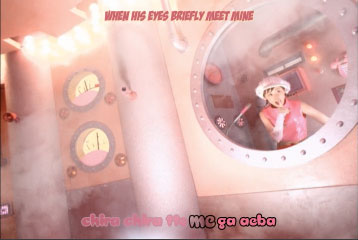Japan
...but it did have a nice view
The Shinagawa Prince hotel is…okay, with short, stiff beds (one crunchy pillow each), extremely small rooms, and over-priced restaurants. It does have a decent convenience store, and the 24-hour pizza/pasta place is reasonably priced and turns into a breakfast shop in the morning. Its real virtue is location: a short walk from Shinagawa Station, from which you can go pretty much anywhere in the country.
And, if your room is on the north side, the view is worthwhile.
I will live until I die
Well, that’s what they said at Oowakudani: “eat one, and you’ll live an extra seven years; eat two, and you’ll live an extra fourteen years; eat three, and you’ll live until you die”. Perhaps I should have stopped at two.
This little guy, on the other hand, won’t add anything to your lifespan.
Dear fansub "typesetters",
The purpose of subtitles is communication. This is particularly true of song lyrics, where “karaoke animation” is intended to help people sing the words at the correct time. This means using crisp, high-contrast fonts, and visually indicating the current word in a way that makes it possible to read the entire line.
This does not mean setting them in a hot pink cheesy fat-face font and then exploding each word as it’s sung, leaving behind only a low-contrast pink-on-pink version that’s basically invisible. It also does not mean spinning words that are repeated more than once. It doesn’t matter if the song is called “peach-colored unrequited love” and the entire set of the video is pink. In fact, that just makes it worse.
You are not an artist. You are a tagger, and your work should be scrubbed from the video with the same vigor that a business owner scrubs bad graffiti from the side of her store.

[and I’ve ordered the DVD so I can watch a high-quality version of the video that doesn’t include your “contribution”. I’m doing this despite your efforts, not because of them; don’t pat yourself on the back and think you accomplished something for the artist]
Mt. Fuji
This late in the year, tour operators don’t make any promises about how high up Fuji you’ll be able to go, or how well you’ll be able to see it from a distance. Ice on the roads kept us from getting past the third station, but visibility was clear all day long.
See?
...and I do mean everywhere
Okay, admittedly Oowakudani is a popular tourist destination for both natives and foreigners, but come on. What’s she doing here?
State of the Musume
One of the songs on my workout mix is Morning Musume’s I Wish. I hate Tsunku’s background vocals, but otherwise it’s a fun song, and a cute video (albeit a bit confusing to anyone who hasn’t seen their weekly television show…). The lyrics made it a popular concert-closer, especially for “graduation” concerts.
Last night, though, I suddenly realized that not only has the group turned over completely since this video was made, only two of them are still actively producing new singles and videos.
In order of appearance:
- Ai Kago: career suicide. Her smoking scandal benched her for a year, and just as they started the publicity campaign to bring her back into the family, she got caught returning from a hot springs resort with a notorious womanizer. Latest twist: her mom is now promising to pose nude for a photobook.
- Maki Gotou: abruptly retired at the peak of her solo career, allegedly due to burnout.
- Natsumi Abe: successful solo artist.
- Mari Yaguchi: kicked out of the group, still in the family. Popular television host and actress.
- Hitomi Yoshizawa: Retired for family reasons, then resumed a light performance schedule when Tsuji's sudden ilness turned out to be...
- Nozomi Tsuji: retired, married, new mother.
- Rika Ishikawa: leader of spinoff group Biyuuden.
- Yuuko Nakazawa: actress and occasional solo artist.
- Kei Yasuda: recently resurfaced as an actress, still in the family.
- Kaori Iida: solo career on hiatus due to pregnancy and subsequent marriage.
Kago’s the only one who really burned her bridges with Hello!Project. Most of the rest still show up occasionally in a concert, a one-shot group, or a few episodes of Uta Doki.
Akihabara
[Update: link added for the back of the map]
One thing I couldn’t find online before the trip was a good map of places to go in Akihabara. The ones I did find were either inaccurate, incomplete, not to scale, required local knowledge, and/or were drawn with complete disregard for the Western notion that North should either be at the top or clearly marked.
The time I spent marking things up in Google Earth did help me find a few places, but it doesn’t produce useful printouts, so I couldn’t bring it with me as PDFs.
Fortunately, less than ten seconds after we stepped out of the station, a pretty girl in a maid costume handed me this (3MB JPEG). The back side of it has more ads and a sorted list of shops and their block numbers.
This is apparently produced by the folks at Akiba Guide.
[Update: Oh, yes, North is to the right, and in Google Maps the area looks like this.]
[Update: just for fun, I dropped this map into Google Earth, and it’s very well-scaled. There’s some distortion around the south edge, most likely to get everything to fit, but most of the map overlays so well that you can easily locate individual shops.
Also, someone has made a set of Google Maps pushpins that covers some of the highlights of Akihabara in English. There are also two decent ones (1, 2) if you can read some Japanese. The first one is a collection of maid cafes, the other is more general.]





